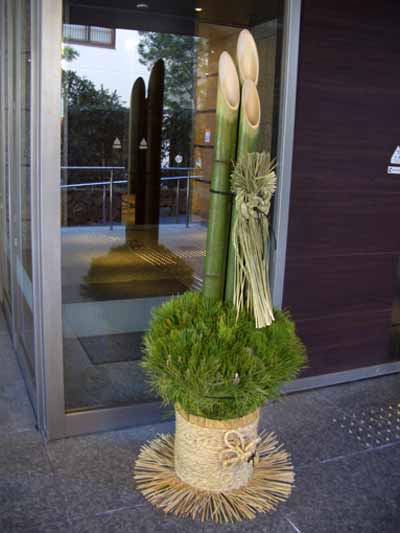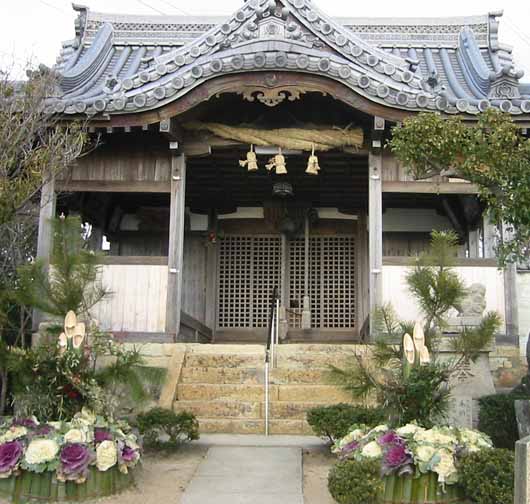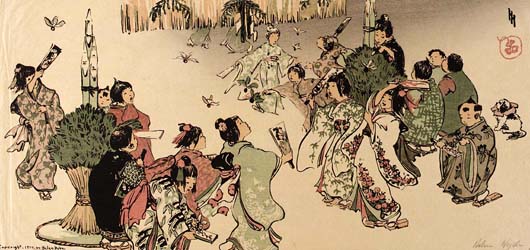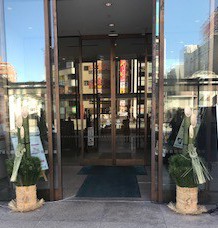Kadomatsu (門松, “gate pine”) is a traditional Japanese decoration for the New Year. Usually two pines (forming a gate) are placed on either side of the front door right after Christmas until January 7th. It’s placed there for good luck in the New Year.
This tradition seems to date back 950 years and is still practiced today. I asked Sadao from Japan about it and he wrote:
“Yes we have a custom to decorate Kadomatsu in front of our entrance. The attached photo (below) is a Kadomatsu in front of our condominium. Using some pine branches, bamboo and rice straw. When we were staying at my old house, we used a rather small one.”

Looking at photos, it seems that nowadays Kadomatsu all have some elements in common: three stalks of bamboo, a pine and a straw sprig bound with a straw rope.
I found the following text about the tradition in a book called, “The Flowers and Gardens of Japan” by Florence Du Cane from 1908…
“…the most important decorations in front of every house at the New Year; the first seven days of the year are called Matsu no uchi or “Within the Pines.” The origin of these Kadomatsu dates as far back as eight hundred and fifty years. One of the old Kadomatsu poets says—
Kadomatsu no, itonami tatsuru sono hodoni
Haru akegatatano yoya narinuran.
(While busy decorating the pines at the gate,
The dawn of the New Year speedily comes.)
The pines in front of the gates are placed in pairs—the rougher and more prickly one, called Thunbergi or male pine, on the left, which is the side of honour in Japan; the softer and more graceful one, P. densiflora or the female pine, on the right. The custom of adding bamboo is of more recent origin; and the other decorations include a rope, especially named shimenawa, with strips of white paper, a cray fish, ferns, a large orange called dai dai, a leaf or two of an evergreen tree, dried persimmons, dried chestnuts, etc. Each one of these articles has its own peculiar origin, and is a symbol of good luck for the year and for life. The poet Ikku Zenzi writes—
At every door the pine-trees stand,
One mile-post more to the spirit land;
And as there’s gladness, so there’s sadness.
And indeed, whatever the pine-trees at the gate may mean, it is for ourselves to choose whether we be happy or sad.”
Let’s choose to be happy in the new year!
Many thanks to Sadao Mazuka for sharing his photo of kadomatsu!
Happy New Year!
-Mama Lisa
Here’s a photo Ayako Egawa later sent with the note, “I’m attaching a photo of Kadomatsu (below). It’s displayed in front of a hotel. Recently we also decorate with New Year wreaths with pine and some lucky items.”
Images
1st Photo: Wikipedia, cc.
2nd Photo: Sadao Mazuka
3rd Image: New Year’s Day in Tokyo by Helen Hyde (1912)
4th Image: Ayako Egawa
This article was posted on Friday, December 29th, 2017 at 10:58 pm and is filed under Countries & Cultures, Customs and Traditions, Holidays Around the World, Japan, New Year's Day, New Year's Eve, New Years. You can follow any responses to this entry through the RSS 2.0 feed. You can skip to the end and leave a response. Pinging is currently not allowed.
Leave a Reply



























